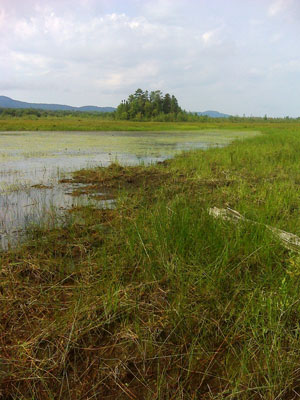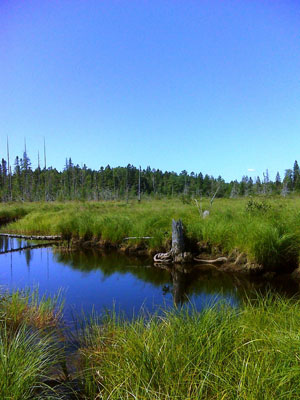DACF Home → Bureaus & Programs → Maine Natural Areas Program → Communities, Plants, and Animals → Natural Community Fact Sheets → Sedge Meadow
Printer Friendly Fact Sheet - 1 MB pdf (Get a free copy of Adobe Acrobat Reader)
Sedge Meadow
Scientific Name: Tussock Sedge Meadow; State Rank: S4
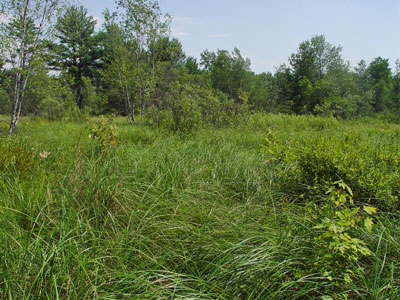
- Community Description
- Soil and Site Characteristics
- Diagnostics
- Similar Types
- Conservation, Wildlife and Management Considerations
- Distribution
- Characteristic Plants
- Associated Rare Plants
- Associated Rare Animals
- Examples on Conservation Lands You Can Visit
Community Description: These graminoid marshes are dominated by hummocks of tussock sedge interspersed with bluejoint, other graminoids, and a few shrubs. Shrub cover is usually less than 30% but may occasionally be higher; meadowsweet is a characteristic shrub. Other wetland sedges and grasses are scattered in with the tussock sedge and bluejoint grass, usually in small amounts. Plant species vary from site to site but typically include royal fern, cinnamon fern, sensitive fern, St. Johnswort, flat-topped goldenrod, or wool-grass. Bryophytes are usually very sparse. Back to top.
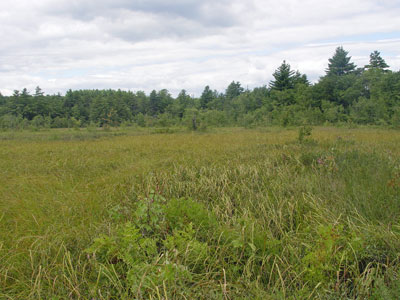
Soil and Site Characteristics: Soils are saturated and usually flooded, sometimes only seasonally. Soils may be entirely organic peat or muck or a layer of organic matter over mineral soil. Standing water is present through much of the growing season. This type typically occurs in large flat basins that are often associated with drainage streams and may be influenced by beaver activity. Back to top.
Diagnostics: Tussock sedge forms greater than 30% cover (usually >50%); shrub cover usually is less than 30%. Vegetation is strongly hummocked with standing water between hummocks for much of the growing season. Back to top.
Similar Types: Tall Grass Meadows share many species but have lower abundance of tussock sedge and are usually only temporarily flooded. Sweetgale Fens and Alder Thickets can also share species with this type but are more strongly dominated by shrubs (>25% shrub or dwarf shrub cover, and usually >50%), and with <25% cover of tussock sedge. Grassy Shrub Marshes also have <25% tussock sedge. Back to top.
Conservation, Wildlife and Management Considerations: While graminoid marshes are common throughout the state, the Tussock Sedge Meadow type of graminoid marsh is more restricted in its distribution. Several are known from public lands and private conservation lands, including some very large and intact examples. Maintaining appropriate wetland buffers can help ensure that adjacent land uses do not result in degradation. This wetland type is particularly susceptible to alteration from the non-native purple loosestrife.
The rare Tomah mayfly is found in a few large sedge meadows in central, eastern, and northern Maine. In addition to numerous common bird species, the rare sedge wren nests in graminoid marshes and wet meadows. Northern harriers may also nest and forage in these meadows. Northern leopard frogs forage in large grassy meadows associated with watercourses in mid-summer. Some sites may function as vernal pools, which are important breeding habitat for a variety of amphibians including wood frogs, spotted salamanders, and blue-spotted salamanders. In southern Maine, these wetlands may provide foraging habitat for ribbon snakes, Blanding’s turtles, and spotted turtles. Back to top.
Distribution: Statewide, extending throughout the northeastern U.S.; Canadian distribution unknown. Landscape Pattern: Large Patch. Back to top.
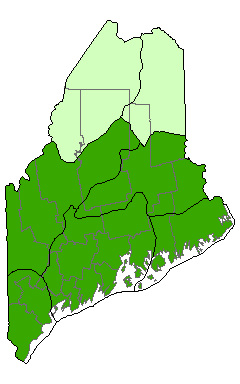

Characteristic Plants: These plants are frequently found in this community type. Those with an asterisk are often diagnostic of this community.
- Sapling/shrub
- Meadowsweet*
- Speckled alder*
- Winterberry*
- Dwarf Shrub
- Leatherleaf
- Herb
- Bluejoint*
- Tussock sedge*
- Bryoid
- Sphagnum mosses
- Blanding's turtle
- Comet darner
- Least bittern
- Ribbon snake
- Sedge wren
- Short-eared owl
- Spotted turtle
- Tomah mayfly
- Yellow rail
Examples on Conservation Lands You Can Visit
| Example | County |
|---|---|
| Cold Stream, Passadumkeag | Penobscot Co. |
| Great Heath Public Lands | Washington Co. |
| Middle Pond State Park | Oxford Co. |
| Roberts Pond Inlet, Massabesic Experimental Forest | York Co. |
